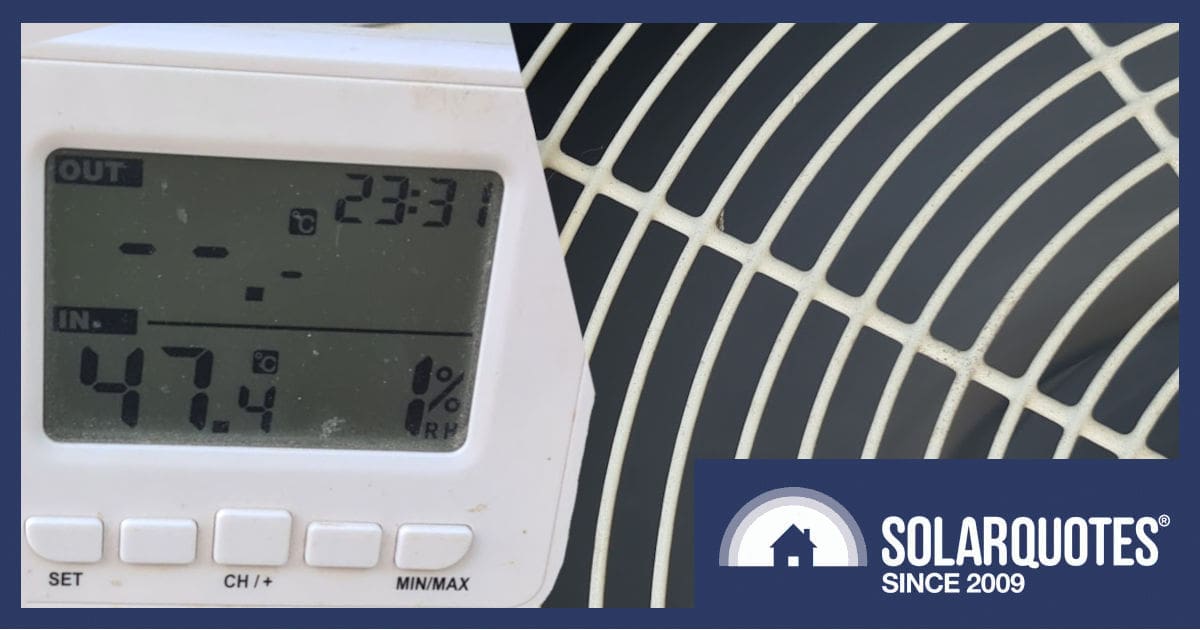
I know it sounds like clickbait, but honestly, there is one simple trick that will help your refrigerative air conditioner cope with very hot days.
It hit 43 degrees in Adelaide the other day, so I challenged myself to write a quick post about heading out into the heat to do a little bit of DIY in the scorching heat, like any sane and rational person would of course.
Our house is a lightweight timber cottage, which is probably 80 years old. While it’s not very big, I’m thankful that it has decent eaves and verandahs, so it does cope with just a single split system air conditioner.
In terms of efficiency and air tightness, it’s about as good as a tent, which is sadly true of most of Australia’s grey roof, low ceiling, veneered McMansion housing stock.
In terms of energy, we’ve got 15kW of solar panels. They both shade about 76m² of roof space and drive 10kW of Fronius inverters, so if the sun is up there’s plenty of capacity to just run the aircon flat out if need be.
Better still there’s a 4.5kW western facing array, so the solar will provide energy to run the AC right up until sunset. It’s the fundamental reason I always recommend more solar.
Backup Would Be Nice
It makes me a little nervous to know that if this air conditioner fails, it probably won’t be at a good time, and we don’t have any redundancy.
This is one of the reasons I recommend heating and cooling your house with multiple split systems instead of one large ducted unit (or a multi-head split).
Aside from being able to heat or cool individual zones more efficiently, you really don’t want a single point of failure that gives up two days before Christmas.
If Your Air Conditioner Seems Tepid
Clean the filters. Seriously.
You’ll be amazed or disgusted at what you find when you pop the front cover off a window rattler unit or flip up the front of an average high-wall split system.
For most splits, there’s a plastic screen that slides out, which you can hose off outside or in the laundry sink.
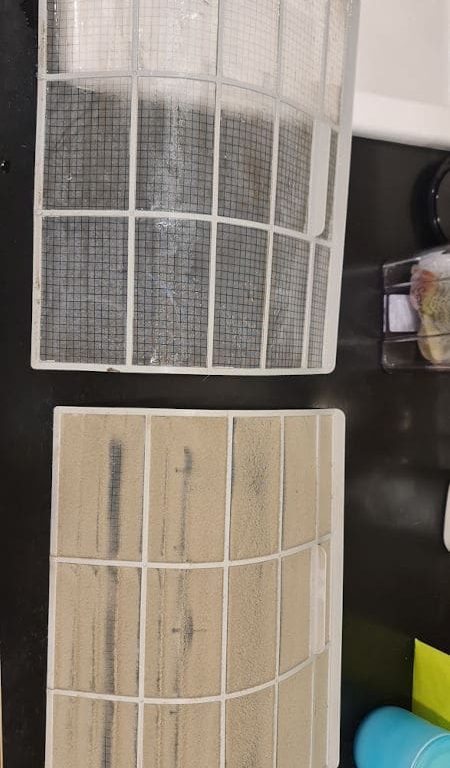
This is only a few months of dirt buildup.
Ducted systems normally have a grille in the ceiling. At one end, you’ll find a little thumbnut to screw out. The screen swings down on a hinge and then slides out of the holder for cleaning in the same way.
Bigger systems have replaceable filter inserts that may be accessed from an external air handler on your roof, but that’s usually a job for an air conditioning contractor.
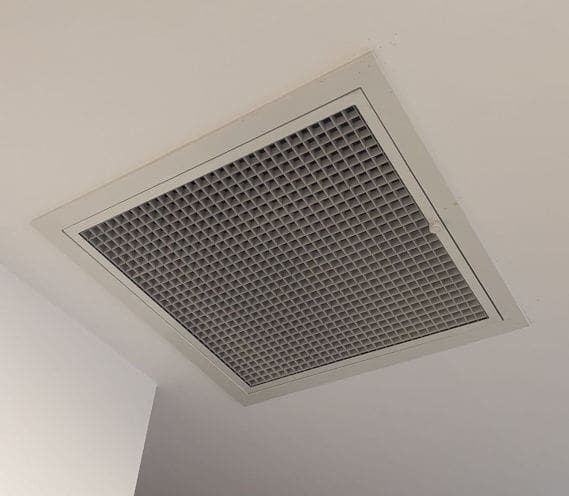
The thumb nut is on the right-hand edge, don’t fall off your ladder getting to it.
Check The Outdoor Unit
Our resident head of security has set up his food waste interception point at the back door, right next to the air conditioner.
What does that mean? The fins for the compressor unit are full of dog hair, so the airflow across the condenser isn’t as good as it could be.
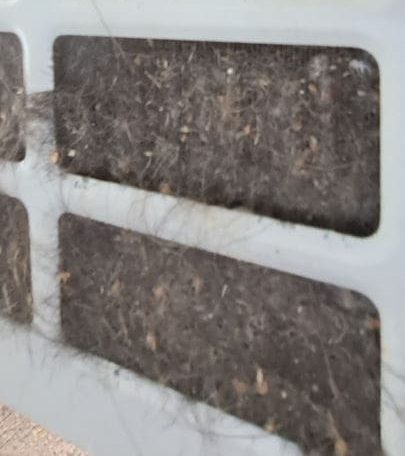
This is not satisfactory
If your air conditioner is terribly soiled like this one was when we moved in, you may need to get somebody qualified to pull the lid off, hose the coil from the inside out, and then use a chemical cleanser to really get the fins clean.
In hindsight, I should have covered the outside of this unit with flywire to intercept the next year’s worth of fluff and make it easier to clean.
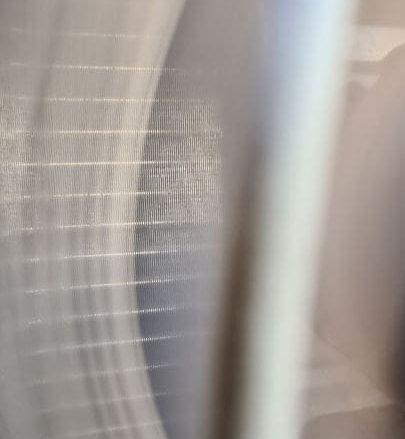
Looking through the fan, the fins are clean. If you turn the power off and direct a decent stream of water (not a pressure washer) through the coil from this side, the dog hair should come away from the other side. Be careful not to douse the electrical components.
If Your Air Conditioner Just Isn’t Coping
The easy way to drastically improve how your air conditioner performs is simply to put a sprinkler on it.
These machines are heat pumps. They take heat from the air inside your house and shift it into the airstream created by the condenser fan.
Dousing the condenser with water helps in two ways. Heat is flushed away in the water as it drips off, while water also makes the coil itself more efficient because it sucks up extra energy as it evaporates into the airstream.
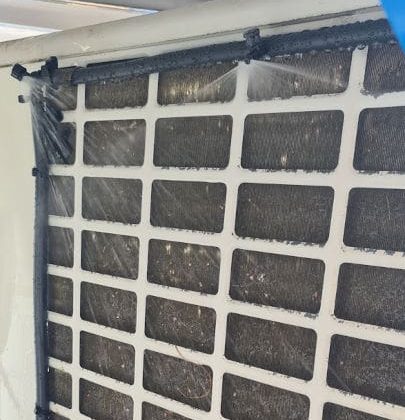
Even just one of these spray jets would likely be enough to do the job
I’ve seen this trick installed commonly on commercial refrigeration plants for shops, pubs and petrol stations. For a handful of hours on a handful of days each year, pouring water on the problem solves heatwave conditions.
In fact, I’ve seen an entire 6-metre-long display fridge emptied, and horrifyingly, all the food binned because the refrigeration couldn’t cope when someone mistakenly turned off the tap on the roof.
Don’t Confuse Evaporative Air Cooling
In southern Australia, many houses have ducted evaporative air conditioning, which is suited to a dry climate.
They work simply by adding water to the air that is blown through your house in large volumes, lowering the temperature by almost 10°C under ideal conditions.
This works especially well in a house with lots of thermal mass. For instance, where overnight temperatures fall to 20°C you can drop the air to around 11°C. This supercooling means houses can cope with high maximum temperatures simply because they aren’t soaked with heat, they have cool inertia.
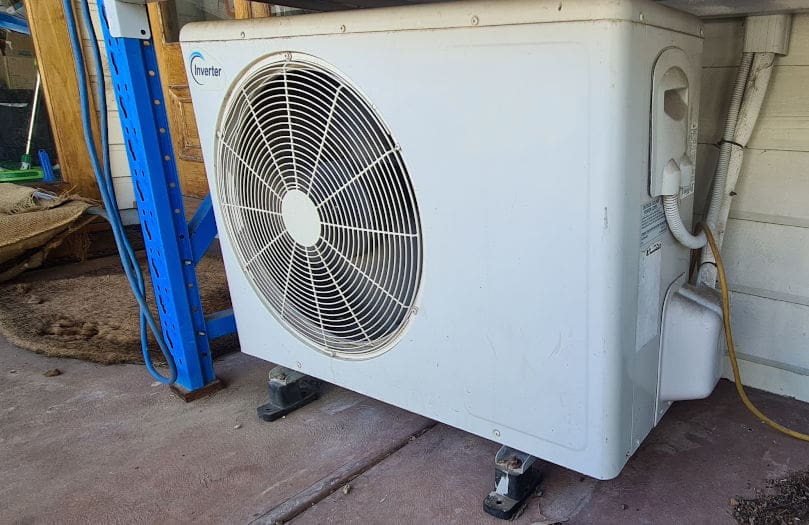
This unit hides under a shelf but it’s not bolted down. Being able to move it away from the wall gently is priceless when it comes to cleaning time.
To Demonstrate
I’ve grabbed a handful of parts at the hardware shop and added irrigation to my air conditioner. After a few minutes of fiddling, I soon realised that I really only need one jet instead of four, as this setup uses a lot of water.
For this domestic-sized unit, a series of adjustable drippers, or perhaps a small section of soaker hose would actually be better. In any case, I would recommend a tap timer just so you don’t forget the water is on.
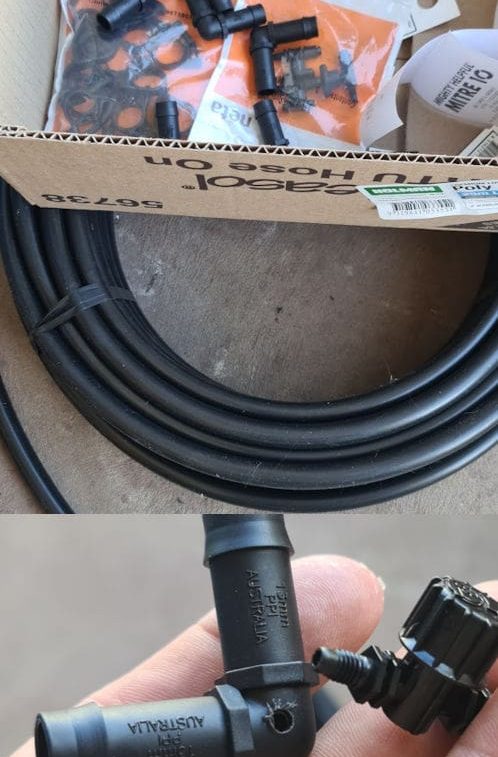
Some of these jets only screw into hard plastic, not soft hose, so drilling an elbow is simple, efficient and more compact.
26% More Efficient
Without going into incredible detail — and without doing any cleaning on the outdoor unit — I measured some before-and-after temperatures and electricity drawn by the air conditioner.
To start with, it was pulling 7.3 amps with hot dry air blown off the condenser a stifling 47.4°C, as per the cover image.
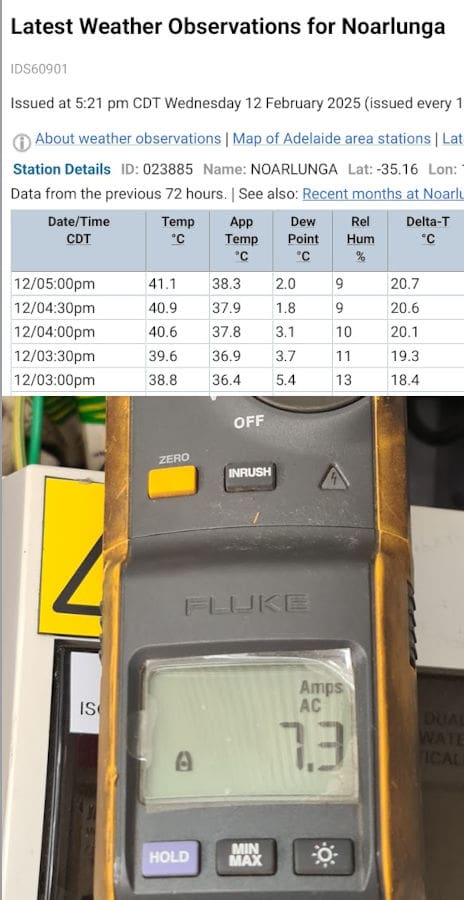
41 degrees nearby and the air con is pulling around 1785watts
After just a few minutes of fiddling with two water sprayers, the condenser was working at 38.7°C and humidity, due to evaporation, had jumped to 27%.
This caused the compressor to back off, as it no longer had to work as hard to maintain the temperature inside the house, reducing the electrical load to 5.4 amps. So with the supply at 245 volts, the difference in energy consumption was 465 watts saved.
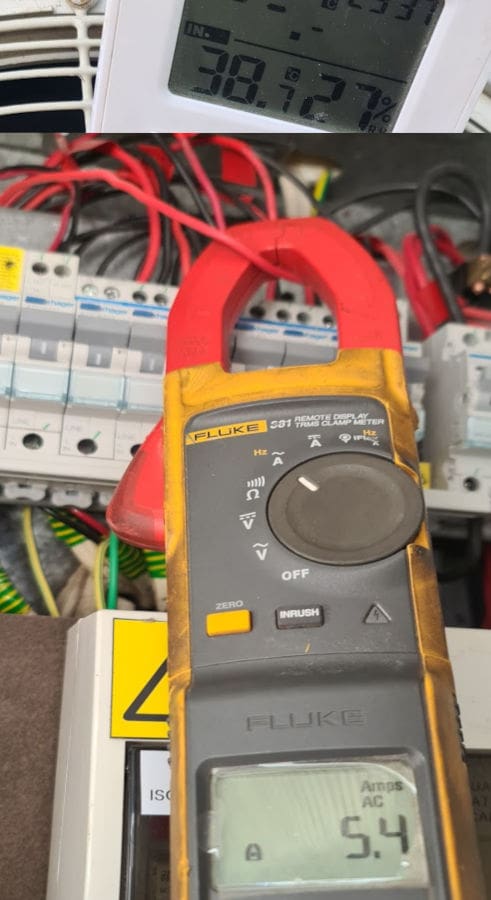
Lower temperature after dousing with water means significantly lower current draw, meaning the air con pulls only 1325 watts
Wasting Water
I won’t hazard a guess as to whether a kilolitre of water will save you a kilowatt hour of electricity, or what each unit is worth.
Nor do I recommend hosing your air conditioner all the time, as the coil might be clogged up with mineral solids and the outdoor unit as a whole will quickly rust away.
Flooding the condenser with water is really just an emergency measure to keep things cool.
It can save the day when the weather is stinking hot and the machinery is running at its limit.

 RSS - Posts
RSS - Posts


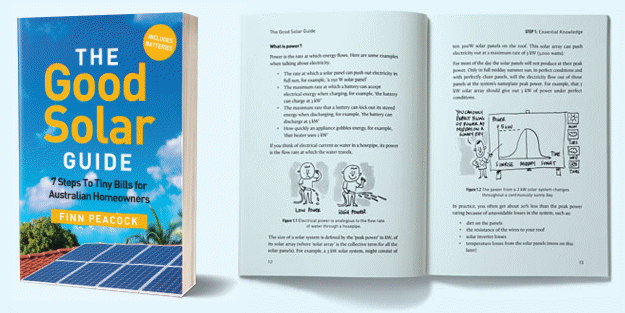
Ensuring the outside placement for a split a/c is kept out of direct sunlight in hot weather. You could probably say the opposite is true in cold weather.
Absolutely agree. Here in cold Canberra we put our central heating/cooling unit on the south side of the house. Problem is we normally don’t need to use a lot of cooling in summer, but boy-o-boy we use it heaps in our very cold winters.
To the extent the unit often freezes and pauses for 10 minutes or so when the ambient temp is below 8 degrees (not uncommon, even during the day).
So, in retrospect we should have had the a/c unit mounted on the northside.
I have done this in the past with a very fine mist spray. The A/C condenser unit is in a garden, so the water doesn’t really get “wasted” … as such.
And yes, it helps.
However our town water is pretty expensive, so I use the mister only very rarely, in extreme weather.
Ha, love it! Shading the outdoor unit might help a (little) bit too, best not to have them in full sun on the northern side of the house? Though I’ve seen professionals say you need to be careful you’re not obstructing airflow with any shade structure as well.
My house has a sizeable thermal mass, and I heat and cool with solar during the day even if nobody is home, to pre-cool or pre-heat the building itself. Doing that I find I can run the splits pretty much 24 hours per day for no significant increase in electricity used.
A social media energy effiiciency group said I was mad, that heat pumps work most efficiently with the smallest difference between indoor and outdoor temperatures. So (they said) letting the house get freezing cold or boiling hot would mean the heat pump would then draw the least amount of power. I said when I trained as an engineer, there was none of this in the thermodynamics, that I thought they were confusing the temperature difference betwene inside and outside the building, with temperature difference between inflow and return air, in the unit itself.
I was kicked off the group.
Hoooray
Australians clocking onto misters on ACs.
Google Cool n Save for a Youtube on it.
Yep been doing this for about 5 years now. Can confirm 30% efficiency improvement. The only risk is hard water clogging the fins but these things are designed to be out in the weather.
Never spray water on the top of condenser as it completely upsets the condensing process. Fine mist no more than halfway up the fins with next to no run off works best because water evaporating is the most effective cooling through the “latent heat of evaporation ” 1/3 up works best. That condensing pressures are maintained
Yeah that makes no sense.
I’ll keep doing what I have been doing for the past FIVE YEARS thanks.
You can “rinse” the fins with demineralized water to reduce build up. Most manufacturers recommend this with corrosion treated coils (factory coating or Blygold)
Hi DGS,
What do you think is the best chemical solution for cleaning coils?
I realise some have special coatings to prevent corrosion & so help maintain heat transfer.
However wheather they’re indoors or outdoors they can still get dirty or greasy.
Hmm, the water mister is an interesting idea.
Think I would prefer to clean the unit condenser before setting up a system like that . . .
I have had air cond cleaning vids come up on YouTube in the past, just had a look through with a basic search, plenty here on how to clean them.
It’s on my list to do our 4 split units through the home !!
https://www.youtube.com/results?search_query=how+to+clean+a+split+air+conditioner+condenser
I like this. Always clean airfilter and makes a difference. Had first service in 9 years recently and it sounds better and electricity use a little better.
But have been wondering about water or shading to keep the heatpump cooler.in summer.
Any thoughts on an awning or umbrella to cover unit and the impact on energy= efficiency?
Even more efficient is to blow a evap cooler into the condenser. We did this at my worksite and it really helped the 5 refrigerated units on hot days
I run a fairly large water chiller to keep the ~13000 litres of water in my aquaponics system cool for the rainbow trout over summer, the water needs to be kept below about 20C. For the past 10 years since I put the system together, once it gets over about 32C I run a fine misting spray over the chiller condenser to reduce energy use in my off-grid system and improve the water cooling.
It uses less than 10 litres of water per hour, vastly less than what I can see in the photo in the article above! I cant exactly remember the calculations I did on it years ago, but there was a significant increase in COP, in the order of 25 – 30%.
I think you could be saving a heck of a lot of water, we cant afford to waste it here, our only supply is what the house roof catches
Very interesting!! and much appreciated AB,
Could you put a diagram up for doing this with ducted Air Con?
Cheers
Matt
Excellent article! I don’t have aircon at my own place but my parents have a ducted Daiken system and I will be checking their outdoor condensor this weekend! I did already notice that being ducted there is an intake grille in the ceiling of the open plan living area, however there is no filter in it and hasn’t been since my parents bought the place 9 years ago. Is this important to have? And how easy to make one to size, or buy, if necessary?
You might be surprised just how much energy it saves, 1 litre of water takes away 0.6kWh of heat. This brings the condensor temperature down to the “wet bulb”, which on the BOM’s observations you can find by subtracting the “delta-T” from the air temperature.
In your screenshot, when the dry bulb was 41.1, the wet bulb was 19.4. The head pressure the compressor faces is reduced.
It is also worth pointing out, in very dry air, there is a more powerful evaporative cooling strategy called multi-stage, or “dew point” cooling. Imagine you used water to cool an air stream to ~25°C, then used this to cool dry air. Now the wet bulb temperature of the cooled air stream is just 13 degrees. Add water to that and you can cool yet another air stream. You can keep chaining the process until the air approaches the dew point, where it no longer absorbs water.
This could provide supply air at about 5 degrees celcius in your hot, dry conditions, at the cost of only water and a fan. Despite a patent for such a system being purchased by an Australian company, Seeley, it is not sold here.
i spoke to Seeley multiple times years ago about indirect evaporative cooling, the system you’re describing. Where the cooled air stream never comes into contact with the cooling water, a real plus in terms of disease prevention too, and similar cooling to a residential heat pump. It could never understand why it wasn’t taking off as a product, and still don’t. I think often used as pre-cooling in commercial air conditioning systems, to reduce energy use.
They did progress to residential units, but have never seen them in Oz, as you say.
Thanks Liam,
Fascinating insight. Evaporative units have been popular here but held in lower regard as a “swamp box” that doesn’t work.
Sadly, when people experience a poorly maintained evap unit it gives them all a bad reputation.
To my knowledge Seely have the best evaporative pad material as tested under Australian standards.
The units they sell with a direct drive hub motor in a traditional scroll fan are remarkably cheap to run. They’re also far quieter than a cheap propeller fan, both inside & outside the house.
I know people who much prefer the air quality from turning the air volume of the house over every couple of minutes.
As houses are made less draughty and more energy efficent, evaporatives are falling from favour though.
Until now however I’ve not seen a good explainer as to how I think what they call their “climate wizard” machines actually work.
Cheers
Correct me if I’m wrong, but I thought you weren’t supposed to run your AC at more than about 10°C\20°F below whatever the external temperature is?
And if 33°C is a mite warm, use fans so that you get the ‘wind chill effect’ assuming that still applies.
You could also use a gel cold pack from your freezer, though you might want a layer of insulation to avoid the shock of something ‘supercold’ directly on skin.
Or you could simply stick your feet in a cold bucket of water, or the bathtub! 😁 Okay admittedly this assumes you actually can get cold water out of your taps.
If you get truly desperate, then go to your local public library and use their AC. They seem to get used for pretty much everything that isn’t book\reading related so why not use it as a ‘heatwave’ survival site too? 😕 If you plan to spend the day then remember cold drinks and food though – just don’t make a mess.
“Cold bucket of water?”
George, in Summer, hot water comes out of both taps ! 🙂
I would suggest using water sprays on condenser coils very sparingly as they can accelerate the corrosion of the fins to the point there the condenser needs to be replaced. When I say sparingly, I mean less than 30 hours per year.
The reason I say this, I read the manual for a water to air heat exchanger that I work with a lot and it basically outlines this in the installation/operation manual.
I have also personally witnessed the damage that long time water spray use has done to commercial package units over time.
I would recommend cleaning them and only use the water spray on the absolute hottest days only and even then only for the time it’s over 40
If you live in a place where it is really hot all the time, over size the unit and make sure it is installed out of direct sunlight and if that is unavoidable face the coil away from the sun direction.
> When I say sparingly, I mean less than 30 hours per year.
When I had to rely on trucked in water during the drought in 2019, the pH 8.8 town water full of Calcium certainly coated the fins a bit, and going back to rain water partly cleaned that up, but they still have some deposits now.
The condenser has had several thousand hours worth of water spraying to date, and the fins look pretty good, even keeping the blue colouration in areas without Ca salt deposits. I think they are Titanium though, not Aluminium (Alooominum for those in the USA), which is more corrosion prone.
We have been very lucky with our new property that the two existing A/C systems and the third we added after moving into our new house are all in shaded areas for the majority of the day. Turning them on early once the new large solar system we added has begun producing electricity means we can keep the house quite cool for the whole day and most of the night without stressing the A/C units outside. We’ve never needed to contemplate using extra water to cool the units but you never know, the day may come in the future where this information will come in handy.
A few years ago, one February, we experienced a whole week, of STINKING HOT North-Westerly Winds and resulting 46 degrees-C Days here in Brisbane, which saw our home’s two, poor old Aussie made Kelvinator R-22 Split System ACs that were both then on about their 20th birthday each at the time, REALLY Struggling to cope, and so I recalled that I had seen in the past, Commercial AC Installations using Water Cooling over their Condensers and so I went off to our local Hardware and, to our local Gardening Supplies Store and returned with enough 1/4″ irrigation tubing and Very-Fine Spray, Misting-Nozzles, and accessories to rapidly throw together a jury-rigged contraption that I then fitted to the rear of each of our ACs and connected all of that, to our house’s rear garden tap, via an in-line 1.0 Micron water-filter and then turned it all on and was Amazed, at the instant recovery of both, of our AC’s ‘own happy-composures again’ and, of our lovely, once more, Cool-Air, inside, of our house.
After that shocking experience, I figured that I owed it to our two old, and very Faithful, Kelvinator Units, to give them a well deserved retirement, and so they have now both, sailed off to their well deserved rest, in their AC’s Valhalla, and have been replaced with modern Mitsubishi Inverter R-32 Type. Now waiting to see, if we’ll get 20 years, of trouble-free service out of the Mitsubishi’s like we got, from our old Aussie made Kelvinators. ?
If you size your air conditioner correctly at installation time you don’t need misters or worrying about the outdoor being in the shade. After working in the Pilbara for the last 16 summers air conditioners run 24/7 for the whole summer cranked up to 18 degrees on 45 degrees days with no troubles.
The extra few hundred bucks you pay for a 7.1kW cooling unit vs a 5kW are worth the comfort on a 40+ day.
Most modern day inverter air conditioners have control boards that ramp the outdoor fans & compressors up & down to maintain the correct head pressure to allow oil circulation around the system. Artificially lowering the head pressure with misters might save you a few bucks but in the long run the extended oil migration is doing more damage to the compressor.
Most residential installers undersize units to be competitive on quotes by using a flat 125W cooling per square metre of floor area. But when you then add the heat load from windows, ceilings & electrical appliances its probably closer to 200W/ square metre.
Most air conditioners rated capacity is based on the assumption of indoor being set to 27 degrees on a 35 degrees day.
Very good info Floyd,
Thanks for the detailed response. While it appears to be a half arsed solution, the places I’ve seen misting gear installed are million dollar petrol station convenience stores with thousands of dollars of food stock at risk.
Unlike the Pilbara, Adelaide doesn’t regularly see temperatures over 40 degrees, so sizing a system for a handful hours on a handful of days per year isn’t really efficient. Rather they install something that’s fine for 99.7% of the time & then use water for emergencies basically.
It’s the same logic applied to the electricity network, which is running at 40% capacity on average. SAPN and the consumers couldn’t afford to build a Pilbara style network 😉